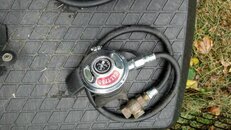Interesting comment and a good point.
We cascade fill our own portable O2 tanks at work. We probably fill an average of 5 tanks/day, and I have worked there over 11 years now. There is no bleeder valve in our system, we just turn off both valves (cascade and tank) then loosen the yoke fitting to bleed off pressure. Nothing crazy has happened yet.
I know this is probably not the safest practice (I leaned this in the past year as I have started reading about at home gas blending) but it is not as scary as it is made out to be either. When I started reading the O2 Hackers guild I would have been scared to even work with O2 had I not done it for so long. O2 Hacker states filling at 60psi/min yet I have seen MANY folks fill tanks almost as fast as they will fill. When I was "taught" I was told to fill slow but even then it was still probably 500+psi/min.





